brought to you by: Dave Williams
This page: www.bacomatic.org/~dw/fordv8/hipo/hipo.htm
Main page: http://www.bacomatic.org/~dw/index.htm
Last Updated: 16 Sep 2003
Author: Dave Williams; dlwilliams=aristotle=net
The HiPo came with an ordinary cast iron 4V intake, an Autolite carb, stamped steel valve covers, and standard 289 oil pan without a windage tray. Most of the HiPos you see nowadays have the Ford or Shelby dress-up kit with the cast aluminum valve covers and intake.
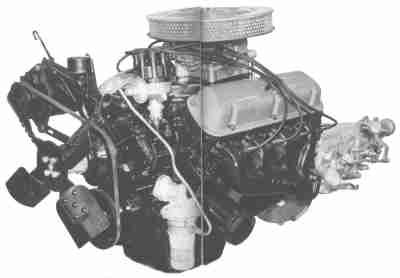 Ford 289 High Performance. This is a 1964 model with generator, timing cover
oil fill, and vacuum advance.
Ford 289 High Performance. This is a 1964 model with generator, timing cover
oil fill, and vacuum advance.
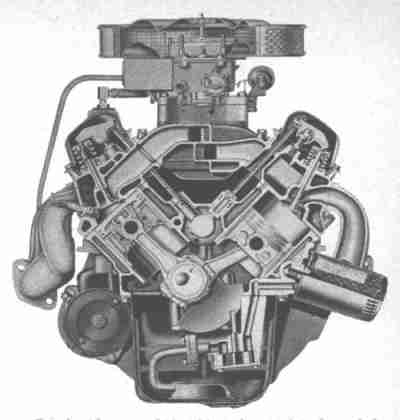 Cutaway view of a HiPo. You can make out the spring cups in the heads, the
screw-in studs, open-element air filter, and the swept exhaust manifolds.
Cutaway view of a HiPo. You can make out the spring cups in the heads, the
screw-in studs, open-element air filter, and the swept exhaust manifolds.
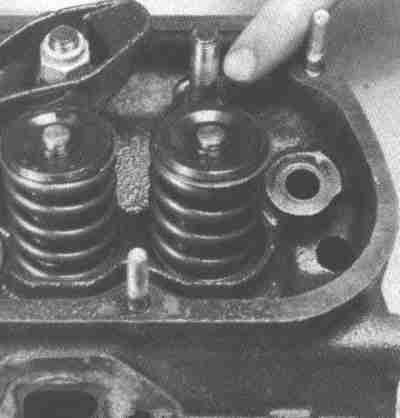 You can't see it here, but the HiPo heads have screw-in studs. They did not
have guide plates; Ford used "close-tolerance slots" in the head castings to
guide the pushrods. This meant they could use ordinary non-hardened pushrods.
Screw-in vs. push-in studs was just a matter of machining the casting.
You can't see it here, but the HiPo heads have screw-in studs. They did not
have guide plates; Ford used "close-tolerance slots" in the head castings to
guide the pushrods. This meant they could use ordinary non-hardened pushrods.
Screw-in vs. push-in studs was just a matter of machining the casting.
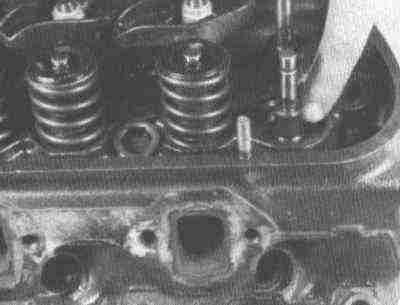 This and the picture above show the Hi-Po heads' only unique feature - the
"cup" that holds the valve spring. If you see the cup, they're HiPo heads.
The valve cover studs aren't stock.
This and the picture above show the Hi-Po heads' only unique feature - the
"cup" that holds the valve spring. If you see the cup, they're HiPo heads.
The valve cover studs aren't stock.
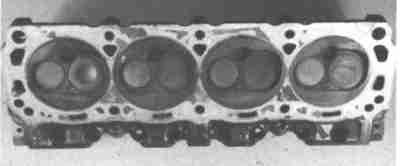 Other than the cup the castings were absolutely ordinary 289 4V heads. Same
combustion chambers, same ports, same valves, same everything.
Other than the cup the castings were absolutely ordinary 289 4V heads. Same
combustion chambers, same ports, same valves, same everything.
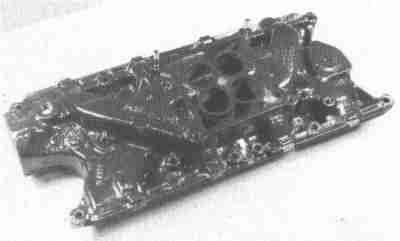 The HP came with a perfectly ordinary cast iron 4V intake - the exact same one
used on the plain old 4V engine.
The HP came with a perfectly ordinary cast iron 4V intake - the exact same one
used on the plain old 4V engine.
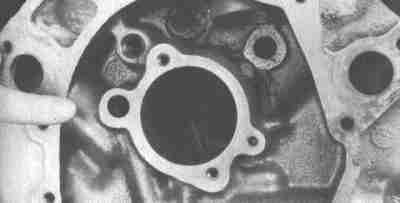 Finger is pointing in the general direction of the oil galleries. The HiPos
had threaded plugs in the oil galleries... but so did some of the ordinary
low-po engines.
Finger is pointing in the general direction of the oil galleries. The HiPos
had threaded plugs in the oil galleries... but so did some of the ordinary
low-po engines.
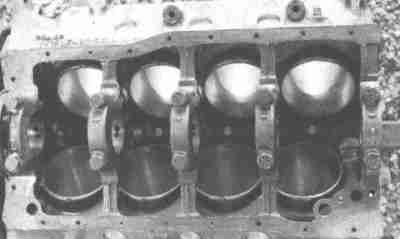 Here's a 289 High Performance block from underneath. Other than the main caps
there's nothing to distinguish it from an ordinary 289.
Here's a 289 High Performance block from underneath. Other than the main caps
there's nothing to distinguish it from an ordinary 289.
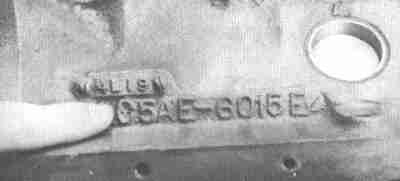 Indeed, the HiPo block has the same casting number as an ordinary 289; the
same one as the low-compression 2V block in my car.
Indeed, the HiPo block has the same casting number as an ordinary 289; the
same one as the low-compression 2V block in my car.
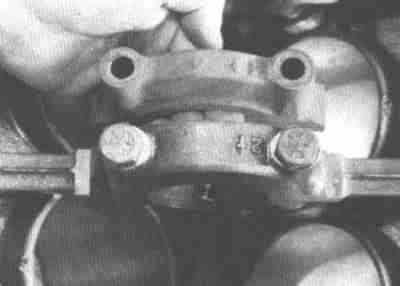 Top view of the famous HiPo main caps. Some purists warn against the
possibility HiPo caps might have been retrofitted to an ordinary block, but
the HiPo block *is* an ordinary block; only the caps make it a HiPo.
Top view of the famous HiPo main caps. Some purists warn against the
possibility HiPo caps might have been retrofitted to an ordinary block, but
the HiPo block *is* an ordinary block; only the caps make it a HiPo.
Some '70s Mexican-cast 302s have the same caps, by the way.
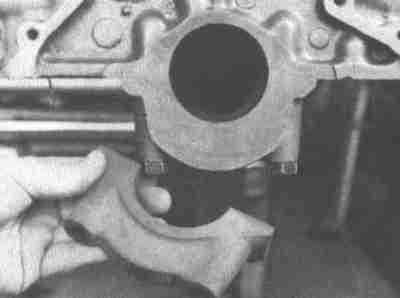 Front view of the HiPo main caps. Yes, they're beefier than the standard
caps, but main cap failure doesn't seem to be a problem with the small Fords
anyway, even with stroked 5.0s with blowers or nitrous.
Front view of the HiPo main caps. Yes, they're beefier than the standard
caps, but main cap failure doesn't seem to be a problem with the small Fords
anyway, even with stroked 5.0s with blowers or nitrous.
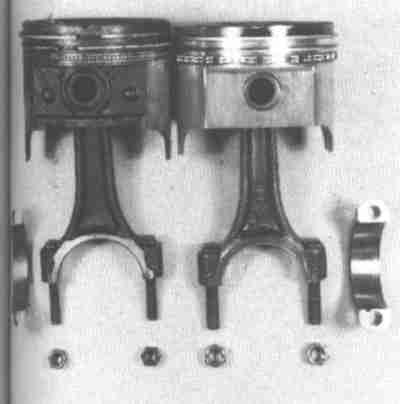 Another special HiPo part - the connecting rods were machined to take 3/8"
bolts instead of 5/16" bolts. The only other small Ford with this rod was the
BOSS 302.
Another special HiPo part - the connecting rods were machined to take 3/8"
bolts instead of 5/16" bolts. The only other small Ford with this rod was the
BOSS 302.
 Here's a HiPo part - the thick harmonic balancer. It's supposed to be unique
to the HiPo, but it looks a whole lot like the early '70s 302 thick damper or
the BOSS 302 damper. I can't tell them apart by eye; I'm not even sure
they're all different. Ford also sold the HiPo balancer over the counter. So
did Shelby American, who'd mark it in 1-degree increments all the way around
for a small additional fee.
Here's a HiPo part - the thick harmonic balancer. It's supposed to be unique
to the HiPo, but it looks a whole lot like the early '70s 302 thick damper or
the BOSS 302 damper. I can't tell them apart by eye; I'm not even sure
they're all different. Ford also sold the HiPo balancer over the counter. So
did Shelby American, who'd mark it in 1-degree increments all the way around
for a small additional fee.
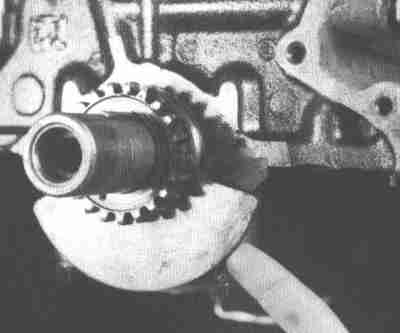 Now this is a unique HiPo part - the front bobweight. The HiPo used a timing
chain with a unique thin lower sprocket to provide room for the bobweight.
If you have a real HiPo with the bobweight, no other sprocket will work! The
bobweight listed for $2.70 in Ford's 1969 Muscle Parts catalog.
Now this is a unique HiPo part - the front bobweight. The HiPo used a timing
chain with a unique thin lower sprocket to provide room for the bobweight.
If you have a real HiPo with the bobweight, no other sprocket will work! The
bobweight listed for $2.70 in Ford's 1969 Muscle Parts catalog.
The weight is a minor mystery. Ford says the external weighting on the HiPo
is 28.2 oz-in, just like the ordinary 289. They also sold the HiPo damper to
use on an ordinary 289, and they did *not* specify the use of the HiPo bob
weight with the HiPo damper! It seemed to work fine. The HiPo crankshaft was
an ordinary cast iron 289 crank, no special machining was claimed.
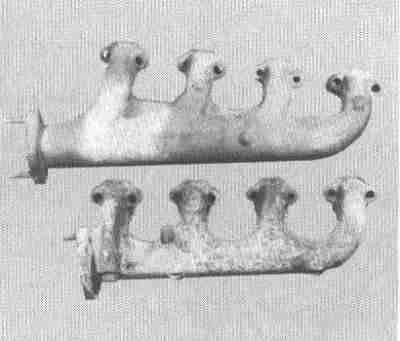 The HiPo exhaust manifolds were unique. Many owners of original HiPos dumped
them in favor of headers, so the manifolds are rare and expensive nowadays.
Oddly enough, they're virtually identical to early 351W manifolds. The 351W
parts aren't quite so streamlined and have various knobs and bumps, but
they're a practical substitute if you don't insist on absolute originality.
The HiPo exhaust manifolds were unique. Many owners of original HiPos dumped
them in favor of headers, so the manifolds are rare and expensive nowadays.
Oddly enough, they're virtually identical to early 351W manifolds. The 351W
parts aren't quite so streamlined and have various knobs and bumps, but
they're a practical substitute if you don't insist on absolute originality.
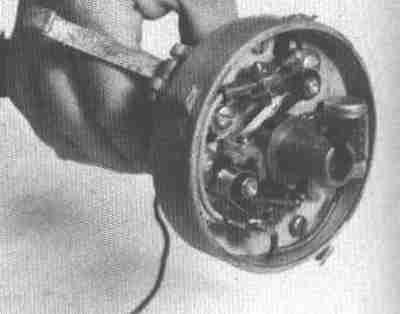 289 HiPos used this dual-point, centrifugal-only distributor. Ford made a
zillion of them, sold them dirt cheap, and marketed them through their
performance parts program. Tuners like Shelby also sold hop-up kits including
the distributor, so it's not a reliable indication of a HiPo.
289 HiPos used this dual-point, centrifugal-only distributor. Ford made a
zillion of them, sold them dirt cheap, and marketed them through their
performance parts program. Tuners like Shelby also sold hop-up kits including
the distributor, so it's not a reliable indication of a HiPo.